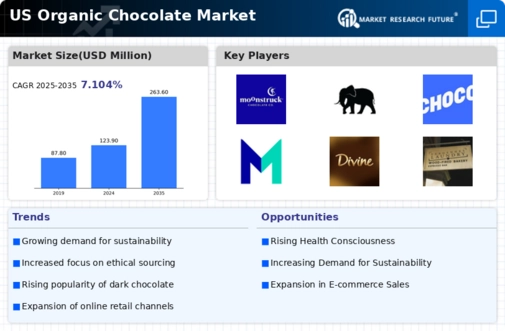Innovative Product Offerings
Innovation plays a crucial role in the organic chocolate market, as brands continuously seek to differentiate themselves through unique product offerings. The introduction of new flavors, textures, and formats, such as organic chocolate bars infused with superfoods or artisanal truffles, caters to evolving consumer preferences. Market analysis suggests that innovative products can lead to increased consumer interest and higher sales volumes. For instance, the launch of organic chocolate products with added health benefits, such as high protein or low sugar options, has been well-received. This trend towards innovation not only enhances the appeal of organic chocolate but also positions brands to compete effectively in a crowded marketplace.
Influence of Social Media Marketing
Social media marketing is playing an increasingly influential role in shaping consumer perceptions and driving sales in the organic chocolate market. Brands are leveraging platforms like Instagram and Facebook to showcase their products, share recipes, and engage with consumers directly. This digital engagement appears to be effective, as studies indicate that brands with a strong social media presence can see sales increases of up to 25%. The visual nature of social media allows for creative marketing strategies that highlight the unique qualities of organic chocolate, appealing to a younger demographic. As social media continues to evolve, its impact on consumer behavior in the organic chocolate market is likely to grow.
Growing Awareness of Ethical Sourcing
Ethical sourcing is becoming a pivotal factor influencing consumer choices in the organic chocolate market. As awareness of fair trade practices and the impact of cocoa farming on communities grows, consumers are increasingly seeking products that align with their values. Brands that prioritize ethical sourcing and provide transparency about their supply chains are likely to resonate with socially conscious consumers. This trend is supported by data indicating that approximately 30% of consumers are willing to pay a premium for ethically sourced organic chocolate. Consequently, companies that adopt ethical sourcing practices may not only enhance their brand reputation but also drive sales in the organic chocolate market.
Rising Demand for Natural Ingredients
The organic chocolate market is experiencing a notable increase in demand for products made from natural ingredients. Consumers are becoming increasingly aware of the health benefits associated with organic products, which often contain fewer additives and preservatives. This trend is reflected in market data, indicating that sales of organic chocolate have surged by approximately 15% annually over the past few years. As consumers prioritize clean labels and transparency in food sourcing, manufacturers are responding by reformulating their products to meet these expectations. This shift towards natural ingredients is likely to drive growth in the organic chocolate market, as brands that emphasize organic certifications and ingredient integrity may capture a larger share of the market.
Increased Availability in Retail Channels
The organic chocolate market is benefiting from enhanced availability across various retail channels. As consumer interest in organic products rises, retailers are expanding their offerings to include a wider range of organic chocolate options. This includes placement in mainstream grocery stores, specialty shops, and online platforms. Data shows that organic chocolate sales through retail channels have increased by 20% in the last year alone. The convenience of access to organic chocolate products is likely to encourage trial and repeat purchases among consumers. As more retailers recognize the demand for organic options, the market is expected to continue its upward trajectory.

























Leave a Comment